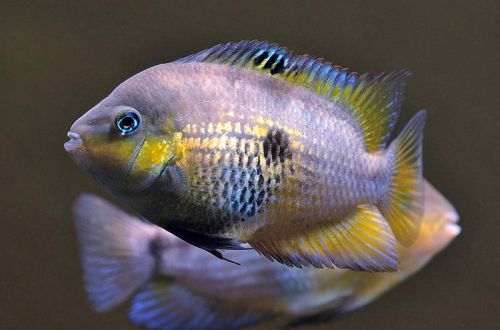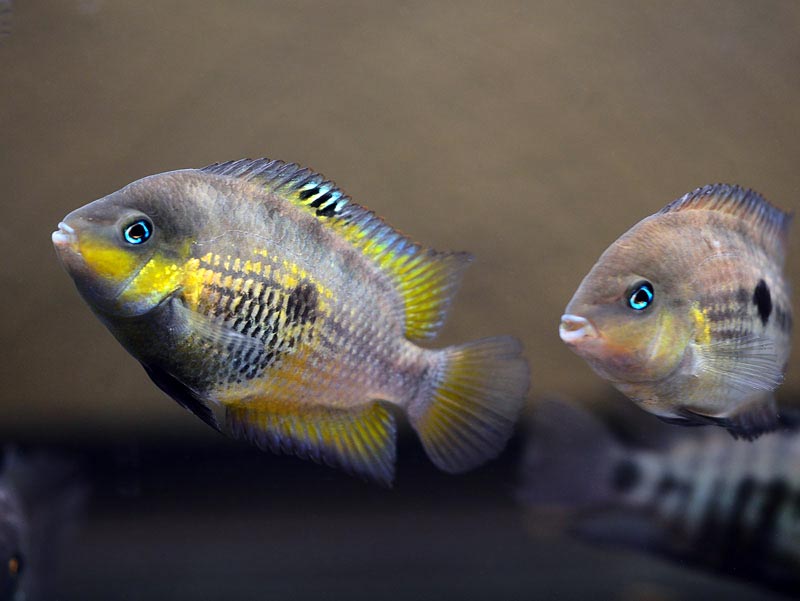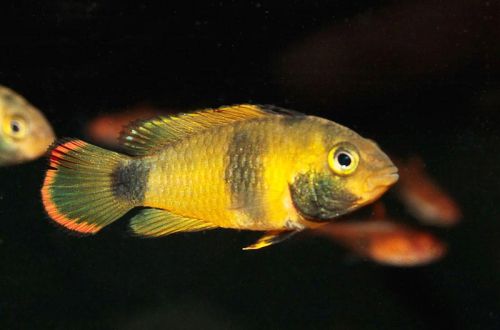
Tsikhlazoma peaceful
The peaceful cichlazoma, scientific name Amatitlania myrnae, belongs to the Cichlidae family. Previously referred to as Cryptoheros myrnae. Despite the name, this fish can be described as very temperamental, especially males. However, compared to many Central American cichlids, they are indeed quite peaceful and able to get along with other species. In a large aquarium, maintenance will not cause much trouble.

Contents
Habitat
It comes from Central America from the territory of Costa Rica and Panama. They live in rivers on the east coast, flowing into the Caribbean Sea. Occurs in sections of rivers with clean clear water, moderate currents and sandy substrates.
Brief information:
- The volume of the aquarium – from 80 liters.
- Temperature – 23-26°C
- Value pH — 7.0–8.5
- Water hardness – 10–26 dGH
- Substrate type – sandy or rocky
- Lighting – subdued
- Brackish water – no
- Water movement – moderate
- The size of the fish is up to 10 cm.
- Food – small sinking food from a variety of products
- Temperament – conditionally peaceful, males are territorial
- Keeping alone or in a formed male/female pair (for small aquariums)
Description

Adult individuals reach a length of 7–10 cm. The fish have a massive body, somewhat compressed laterally, oval in shape. Males are larger and brighter colored. Gray colors are combined with yellow, in which the abdomen and fins are painted. The latter have an additional blue border. Females are smaller in size, the main color is gray, fins with blue hues. In both sexes, there is a black dot in the middle of the body; in females, an additional spot appears during the spawning period at the base of the tail.
Food
Fish undemanding to the diet. In a home aquarium, it will accept most popular foods, such as dry flakes, granules, tablets, as well as bloodworms, daphnia, brine shrimp in live, frozen or freeze-dried form. It is desirable that the feed contains a certain amount of plant components.
Maintenance and care, arrangement of the aquarium
The optimal size of an aquarium for one or two fish starts at 80 liters. When kept together with other species, a much larger tank will be required. The design is simple, it is enough to use a sand and gravel substrate and a few snags in the form of branches or tree roots, from which shelters are formed.
In nature, peaceful cichlomas live in rivers containing a large amount of dissolved minerals, so the hydrochemical composition of water has high dGH and pH values, which must be reproduced and maintained in an aquarium. It is recommended to apply additional aeration, for example, using a pump, which will also ensure the movement of water – a kind of imitation of the flow of a river. Regular maintenance consists of several standard procedures: weekly replacement of part of the water (15–20% of the volume) with fresh water, removal of organic waste (food residue, excrement), equipment maintenance, testing of water for the presence of nitrogen cycle products (nitrites, nitrates, ammonia) and etc.
Behavior and Compatibility
They zealously protect their territory from rivals, first of all, this applies to males, so in a small aquarium it is worth keeping alone or a heterosexual pair. In large tanks they are compatible with other Central American cichlids, provided there is enough space for each and they do not overlap frequently. Able to get along well with fish that live near the surface or in the water column. Among them are popular live-bearing fish such as Guppy and Alfaro turquoise, as well as the more exotic Mexican Tetra.
Breeding / breeding
Breeding is easy if a mature pair is available. Fish are picky about the choice of a partner, so sometimes it is not enough to settle a sexually mature male and female together, and besides, males are unlikely to tolerate the presence of anyone on their territory. A group of young fish must grow together and as a result, one or two pairs can form, which remain faithful to each other for a long time.
During spawning, the female lays up to 200 eggs and takes on the responsibility of caring for and protecting the clutch. The male at this time “patrols” the surroundings of his territory, driving away anyone who poses a potential danger.
The incubation period lasts about 4 days, after another week the fry begin to swim freely. The female continues to protect them for several more weeks, all this time the juveniles stay near her.
Fish diseases
The main cause of diseases lies in the conditions of detention, if they go beyond the permissible range, then immunity suppression inevitably occurs and the fish becomes susceptible to various infections that are inevitably present in the environment. If the first suspicions arise that the fish is sick, the first step is to check the water parameters and the presence of dangerous concentrations of nitrogen cycle products. Restoration of normal/suitable conditions often promotes healing. However, in some cases, medical treatment is indispensable. Read more about symptoms and treatments in the Aquarium Fish Diseases section.





